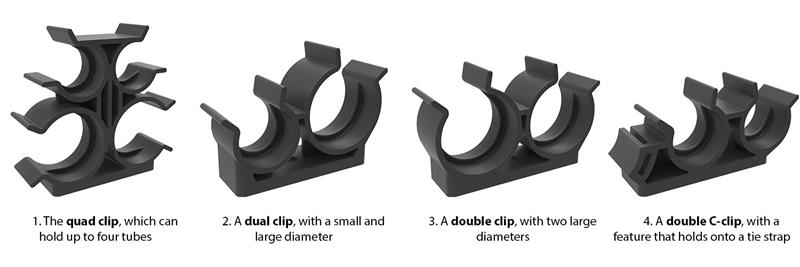ARaymond’s customer typically relied on this C-clip type of component to retain certain tubes and wires as part of its truck’s diesel exhaust fluid systems. For the most part, this worked fine — but there was room for improvement.
“Our customer previously used a C-clip styled part, which is very similar to a component that we also manufacture,” says Jason Reznar, senior development engineer atARaymond.
“It was effective enough for them, but maybe not as efficient or ideal as it could be. So they wanted to know if we could design a clip that could retain multiple tubes.”
The C-clip the customer originally used could only hold up to two tubes together. “They wanted to turn this into a quad clip for their application, which could hold up to four tubes. So that’s what we did.”
Reznar makes this sound simple. But like all good designs, it took some trial and error.
Designing a quad clip is one thing but creating one that fits a specific application requires skill and exceptional communication.
“It’s critical to start such a project with as much information about the application as possible,” says Reznar. “For example, this customer had specific criteria we had to meet because the exhaust system is quite a complicated area with only so much space and certain attachment and mounting requirements.”
Part of this criteria comprised:
- The tube dimensions and features - including length, diameter size, material (rigidity was a factor in this case), and function
- The location of other parts - particularly, the components to stay clear of
- The placement or mounting scheme - such as the direction of the tubes, where they can be attached, which ones must be separated, and any spacing considerations
“There are multiple things that we must factor in when it comes to tube or wire management,” he says. “For this project, it was important to keep the tubes separated from one another, as opposed to using a tie strap. So, this meant designing a new clip, as well as properly orienting its placement in relation to the other tubes.”
Reznar explains that the reason for the separate placement of the tubes was partially cleanliness and aesthetics - one quad-clip meant the use of several C-clips to perform the same function was unnecessary. But, perhaps more significantly, it was about efficiency.
“Let’s say there are maintenance issues down the line that occur in the exhaust system. Now, errors are far less likely if someone only has to pull one tube instead of four to make the repair,” he says. “It’s really a matter of efficiency.”
What’s more: the engineers had to monitor the insertion and watch the retention forces on the clip.
“The C-clip has no closing latch and is simply pushed into place and, essentially, holds itself. So, we needed to balance the insertion versus the retention to ensure that in a 90-degree bend, the tubes would remain in place.”
It turns out this was easier said than done. The design process took a few iterations, which is fairly common with brand-new components.
“Originally, the plan was to mount the new quad clips on to a steel bracket much like a Christmas tree attachment,” he says. The customer was going to test the prototype models. “However, it turns out that the tubes were far more rigid than we initially thought; they were actually forcing the clips out of the brackets, which shocked the customer just as much as it did us.”
Fortunately, the prototypes were fairly simple for ARaymond to create, thanks to its additive manufacturing (3D printing) capabilities. This capability allowed ARaymond to create a quick and cost-effective model of the quad-clip once designed and ship it to the client for testing before committing to the final product. This proved extremely beneficial in this case.
“Thanks to the prototype, we quickly learned that the tubes were troublesome, adding extreme forces to the mounting scheme we had originally planned for this assembly,” he says. The team had to devise an alternative solution.
“So, we re-evaluated everything with the customer and our engineers, and then developed a far more rigid and effective mounting scheme. But, I have to say: the 3D prototype is truly a game-changer for such projects. It helped save time and costs.”

The newly designed quad-clip offered several benefits for ARaymond’s customer, including a less costly and more orderly assembly.
“Typically, for an assembly such as this, traditional C-clips would be stacked and snapped together to make double or quad-like clips,” says Reznar. “However, this not only adds to the component costs but it also leads to liabilities and potential assembly errors.”
Generally, the fewer the parts required, the cleaner the assembly. ARaymond was able to deliver on this benefit by redesigning and moulding several components into just one device.
Interestingly, this project also led to the design of three other components for the customer.
“By asking the right questions and through ongoing communicating with this client, we learned that tube and wire management could also be effective in other areas of their vehicles,” he says. “So, we were able to be versatile in this case by designing a few different clips to suit their needs. The components were all similar but with slightly altered features, depending on their application.”
“It’s always extremely rewarding to be involved with a project like this that, as an engineer, you see through from the beginning design to the approved customer part and then to the final, manufactured product,” Reznar says.
And in this case, ARaymond was able to over-deliver and solve more than one concern for this client by providing multiple new products.










